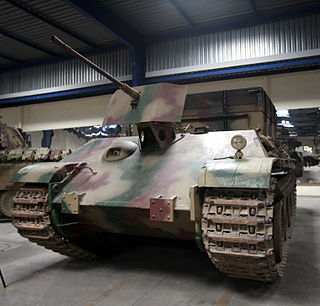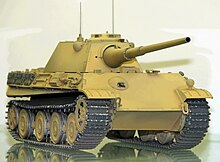
The Tiger II is a German heavy tank of the Second World War. The final official German designation was Panzerkampfwagen Tiger Ausf. B, often shortened to Tiger B. The ordnance inventory designation was Sd.Kfz. 182.. It was known as King Tiger by Allied soldiers, and is also known under the informal name Königstiger.

The Panzer II is the common name used for a family of German tanks used in World War II. The official German designation was Panzerkampfwagen II.

The Panzerkampfwagen III, commonly known as the Panzer III, was a medium tank developed in the 1930s by Germany, and was used extensively in World War II. The official German ordnance designation was Sd.Kfz. 141. It was intended to fight other armoured fighting vehicles and serve alongside and support the similar Panzer IV, which was originally designed for infantry support. However, as the Germans faced the formidable T-34, more powerful anti-tank guns were needed, and since the Panzer IV had more development potential with a larger turret ring, it was redesigned to mount the long-barrelled 7.5 cm KwK 40 gun. The Panzer III effectively swapped roles with the Panzer IV, as from 1942 the last version of the Panzer III mounted the 7.5 cm KwK 37 L/24 that was better suited for infantry support. Production of the Panzer III ceased in 1943. Nevertheless, the Panzer III's capable chassis provided hulls for the Sturmgeschütz III assault gun until the end of the war.

The Panzerkampfwagen IV, commonly known as the Panzer IV, was a German medium tank developed in the late 1930s and used extensively during the Second World War. Its ordnance inventory designation was Sd.Kfz. 161.

Panzerkampfwagen VIII Maus was a German World War II super-heavy tank completed in late 1944. It is the heaviest fully enclosed armored fighting vehicle ever built. Five were ordered, but only two hulls and one turret were completed, the turret being attached, before the testing grounds were captured by advancing Soviet military forces.

The Panther tank, officially Panzerkampfwagen V Panther with ordnance inventory designation: Sd.Kfz. 171, is a German medium tank of World War II. It was used on the Eastern and Western Fronts from mid-1943 to the end of the war in May 1945.

The Jagdpanther, Sd.Kfz. 173, was a tank destroyer built by Germany during World War II. The Jagdpanther combined the 8.8 cm Pak 43 anti-tank gun, similar to the main gun of the Tiger II, and the armor and suspension of the Panther chassis.

Nazi Germany developed numerous tank designs used in World War II. In addition to domestic designs, Germany also used various captured and foreign-built tanks.

The Entwicklung series, more commonly known as the E-Series, was a late-World War II attempt by Nazi Germany to produce a standardised series of tank designs. There were to be standard designs in five different weight classes from which several specialised variants were to be developed. This intended to reverse the trend of extremely complex tank designs that had resulted in poor production rates and mechanical unreliability.

The 7.5 cm KwK 40(7.5 cm Kampfwagenkanone 40) was a German 75 mm Second World War era vehicle-mounted gun, used as the primary armament of the German Panzer IV medium tank and the Sturmgeschütz III and Sturmgeschütz IV tank destroyers/assault guns.

The Bergepanzerwagen V, often referred to simply as the "Bergepanther", was a variant of the Panzerkampfwagen V Panther.

The 3.7 cm Flakzwilling auf Panther Fahrgestell or Flakpanzer 341 was a German self-propelled anti-aircraft gun designed by Rheinmetall during World War II. It was intended to be armed with two 3.7 cm Flak 341 gun in a fully enclosed, rotating turret on the hull of a Panther medium tank. In the end, only a wooden mock-up of the turret on a Panther chassis was built.

The VK 16.02 Leopard was a planned German light reconnaissance vehicle designed from mid-1941 through to January 1943, with serial production scheduled for April 1943. It was intended to be the replacement of Panzer II Ausf. L "Luchs". The project was canceled in January 1943 before the first prototype was completed as it did not meet the requirements for 1944. A wooden mock up of the Waffenträger variant was produced.
Grosstraktor was the codename given to six prototype medium tanks built by Rheinmetall-Borsig, Krupp, and Daimler-Benz, for the Weimar Republic, in violation of the Treaty of Versailles. Constructed in secret, they were tested by Reichswehr units at the Kama tank school in the Soviet Union. They were used for training and retired as monuments after the Nazi party came to power.

The VK 20 series were the proposed replacements of the Panzer IV and Panzer III tanks with entries by MAN, Krupp and Daimler Benz. It was initially projected to weigh 20 tonnes, but grew to 24 tonnes. By November 1941, the designs almost reached completion but against the professional judgement of Wa Pruef 6, political interference in December 1941 led to all of the designs being dropped. The root of this adverse decision came from encounters with increasing numbers of T-34 and KV-1 tanks. Reichsminister Fritz Todt declared that a new tank, 30 tons in weight should be designed and produced. Oberst Fichtner argued that time would be lost developing this new 30 ton tank, the number produced would be reduced and engineer bridges could not support such a tank. This new tank chosen from the VK 30 series would become the Panther, replacing the VK 20 series. This decision would place the rushed MAN Panther into production as Germany's new standard medium tank, which was plagued with issues never fully addressed especially those caused by MAN's final drive. It would also arrive too late, with Germany's position in a steep decline, having lost the initiative.

The Panther II tank, a German tank-design proposal of the Second World War, was based on the design of the Panther tank. It had slightly thicker armour than the Panther and adopted some standardised components from the Tiger II tank design. The Panther II did not progress beyond prototypes and did not enter production.

The Panzerkampfwagen II Ausf. L "Luchs" is a German light tank from the Second World War, developed between 1940 and 1942 by Daimler-Benz and MAN. The Luchs was the only Panzer II design with the Schachtellaufwerk overlapping/interleaved road wheels and "slack track" configuration to enter series production, with 100 being built from September 1943 to January 1944 in addition to the conversion of the four Ausf. M tanks. Originally given the experimental designation VK 13.03, it was adopted under the alternate name Panzerspähwagen II and given the popular name Luchs. The Luchs was larger than the Panzer II Ausf. G in most dimensions. With a six speed transmission, it could reach a speed of 60 km/h (37 mph) with a range of 290 km (180 mi). The FuG 12 and FuG Spr radios were installed, while 330 rounds of 20 mm and 2,250 rounds of 7.92 mm ammunition were carried.

















